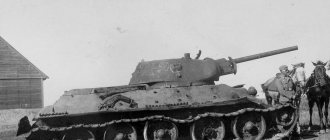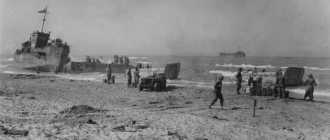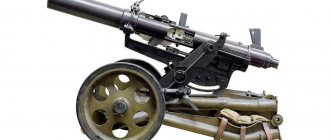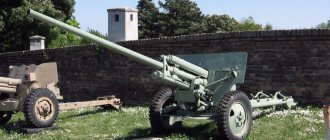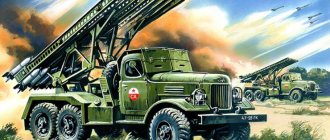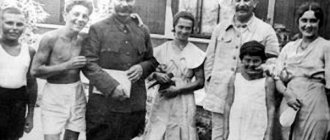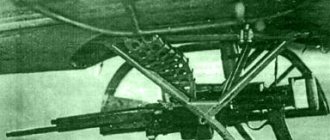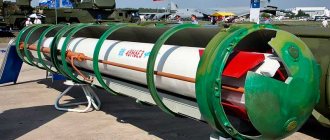Demyansk cauldron and the operation to evacuate it
Some two hundred and fifty kilometers south of Leningrad, between lakes Ilmen and Seliger, at the beginning of 1943 the German front was still deeply mushrooming into Soviet territory.
This was the front of the German 2nd Army Corps around Demyansk. There were twelve divisions in the “mushroom”, approximately 100,000 people. The width of the “mushroom” leg was only ten kilometers. The Demyansk salient, should the offensive on Moscow ever resume, could be an ideal starting position for this operation. The Soviet General Staff understood this very well, therefore, during its great winter offensive of 1941-1942. he turned his attention to the hills of Valdai. Soviet troops did everything possible to break through the German barrier between lakes Ilmen and Seliger and crush the German front at Leningrad and Rzhev with a blow to the rear of Army Groups North and Center. Hitler wanted to maintain this position as a springboard for the attack on Rzhev. The divisions of the 2nd German Corps stood firm. However, on February 8, 1942, they were surrounded and subsequently had to receive supplies by air. At the end of April 1942, an attack from outside and a counterattack from inside the bag restored contact with the main German line on the Lovat River. The constructed bridges again restored the corridor between the main German front of the 16th Army from Staraya Russa to Kholm and the divisions in the Demyansk area. Of course, this corridor leading to the Demyansk battle zone was dangerously narrow, but the 2nd Army Corps held it. He blocked the Russian land road between lakes Ilmen and Seliger, pinning down five Soviet armies. However, throughout 1942 there was a constant threat that Soviet units would be able to cut off the Demyansk “mushroom” at its base; for many months the 100,000-strong German military contingent was on the brink of disaster.
The Soviet High Command recognized this possibility and made the Demian Front one of the centers of its great winter offensive of 1942, an offensive that, according to Stalin's plan, was to end in the complete destruction of the German front in the East. Demyansk was an important factor in Stalin's calculations. Just as Stalingrad was supposed to be the decisive blow that would crush the German Southern Front, so the Soviet offensive on Demyansk was an attempt to eliminate the front of Army Group North. On the Volga, Soviet troops managed to make a decisive breakthrough and defeat the 6th Army. On Valdai, on the contrary, Stalin miscalculated.
To destroy the 100,000-man 2nd German Corps, Marshal Timoshenko deployed three armies: the 11th and 27th armies were to attack the northern front of a narrow strip of land from Lake Ilmen, and the 1st Shock Army was to strike along the corridor from the south. The northern group included thirteen rifle divisions, nine rifle brigades and tank formations, with a total of 400 tanks. Three German divisions opposed this mighty force: the 8th Jäger, 81st and 290th Infantry Divisions. Timoshenko's Southern Group consisted of seven rifle divisions, four rifle brigades and tank formations with 150 tanks. Facing them was the only German division, the 126th Infantry Division from Rhine-Westphalia.
The offensive began on November 28, 1942 with a massive artillery bombardment. Carpet bombing followed. The Russians completely dominated the air, the German troops in the Demyansk area did not have significant Luftwaffe support, and there was not a single significant tank formation. In the first hours of the battle, the Red Army soldiers made several breakthroughs in the northern front of the corridor. Tymoshenko introduced his reserves into the gaps. Lieutenant General Höhne, who commanded the troops inside the corridor, sent sappers, signalmen, artillerymen and drivers to the breakthrough areas. They took everyone from the supply companies and repair shops, every combat-ready person was sent to the threatened fronts of the corridor. But it's all in vain. A decisive breakthrough to the rear of the 16th Army could happen at any moment.
In this dangerous situation, when it became clear that General Höhne’s divisions would no longer hold out, Army Group North took a risky step. In early December, Field Marshal von Küchler withdrew three divisions of his 18th Army from very weak lines along Lake Ladoga, the ring around the Oranienbaum sack and from Volkhov and sent them to the Demyansk corridor. Hitler was unwilling to give up his strategy of defending every inch of territory he had already conquered. He persisted in his theory that far-extended and vulnerable strongholds must be defended in order to maintain favorable starting positions for future offensives. Therefore, the battalions and regiments of three divisions transferred from the north immediately entered into battle. Due to this, the deadly Russian breakthrough to the north was once again prevented. The most difficult situation has developed in Rosino. There, Soviet units broke through to the south with powerful tank support. But in a fierce battle, the Germans managed to block the breakthrough there and create a new line.
Almost unbelievable. Why did Timoshenko, with a huge superiority in manpower and equipment, and a powerful concentration of attacks on several points, fail to achieve a strategic breakthrough of the German front? During the long period of the “state of siege,” German defensive positions were strengthened in the most thorough manner. Anti-aircraft, self-propelled, artillery and assault guns worked superbly together with the infantry. In the next two weeks, Timoshenko continuously tried to break through the northern front with his divisions and tank brigades, then their forces dried up. More than two hundred destroyed Soviet tanks stood in front of the German defensive line.
On the southern front of the Demyansk "mushroom" on January 2, Timoshenko's 1st Shock Army launched another full-scale attack. In forty-six days, from November 28 to January 12, the three Soviet armies lost more than 10,000 killed, as well as 423 tanks. German losses were slightly less. The ferocity of the battle is confirmed by the fact that the list of dead, wounded and missing in the Demyansk corridor includes 17,767 officers, non-commissioned officers and privates. Seventeen thousand seven hundred sixty-seven people in fifty-seven days, from November 28 to January 23! A huge price for an outpost on the Valdai Hills. But there could be no doubt that the Russians would attack again. There could be no doubt that the price would rise and sooner or later the entire garrison would perish. Another Stalingrad.
Is it worth continuing to take such a risk, taking into account the insufficient forces at all frontiers? The combat commanders answered no. “No,” answered Colonel General Zeitzler, Chief of the General Staff of the German Ground Forces. He tried to convince Hitler to sanction the withdrawal of forces from the bastion on Valdai, but at first he was deaf to all arguments. “Hold on” was his thesis. The front's advanced "fortresses" would become, he believed, starting positions for future offensives. Hitler remained committed to the strategy of conquering the Soviet Union through the occupation of its vast expanses and economically important territories. The dire warning of the destruction of Stalingrad swayed him a little, but he was not yet ready to completely reconsider his position.
When in the second half of January 1943 it became clear that the 6th Army had died in Stalingrad because it had not received the order to withdraw from the Volga to the Don in time, Colonel General Zeitzler again turned to Hitler for permission to spare 100,000 people in Demyansk from the fate of 6 th Army, to save these important divisions for the command of the German ground forces. Hitler no longer rejected the request outright; now he wavered between common sense and stubbornness. On January 31, 1943, Hitler gave in to Zeitzler's insistent demands. The next day, February 1, Zeitzler, in a radiogram to the 16th Army, gave the 2nd Corps the green light to evacuate. The retreat actually off-road had to be done gradually, so as not to leave a single weapon behind. Evacuation and work columns were formed, rail tracks were laid, log roads were built, and a system of routes was created radially extending from the “mushroom” cap into the corridor, allowing several columns to be deployed simultaneously. People worked intensively, and prisoners were also involved in the work. Snowplows chugged throughout the area. This is how “Route No. 1”, “Wooden Avenue”, “Kurfürstendamm” and “Silesian Promenade” appeared.
The Germans tried to deceive the Soviet command by passing off preparations for evacuation as preparations for an offensive. Messengers, partisans and intelligence officers reported their observations to the Soviet command, but the Russians perceived the information with distrust. Scout reports from the combat zone and aerial reconnaissance photographs actually spoke of the strengthening of the German front at Demyansk, but a retreat would have been more logical. Take the report about the horses. Infantry divisions returned them from the rear areas to the front line. Doesn’t such a measure indicate preparation for retreat? The Soviet High Command decided to launch a new immediate attack on the narrow corridor of the Demyan bridgehead. “History of the Great Patriotic War” reports on the considerations of the Soviet command regarding this operation. In the third volume we read: “The widespread offensive of the Red Army in the south, in the central sector of the front and near Leningrad pinned down the enemy’s forces and depleted his reserves. A favorable situation was created for the liquidation of the Demyansk bridgehead, on which the main forces of the 16th German Army were concentrated - a total of 12 divisions."
A fair and logical conclusion. The German 18th Army, the 16th Army's neighbor on the left, was seriously engrossed in the events around Leningrad. The 59th Corps south of Demyansk, near Vitebsk, fought heavy battles at the junction of army groups." The 9th Army at Rzhev had been barely coping with the defense for more than two months. And further south, Field Marshal von Manstein needed every battalion to stop Popov's tank group and Vatutin's advance across the Donets to the Dnieper. Therefore, it was absolutely clear that the 16th Army could not count on effective help from its neighbors if the situation around Demyansk became tense again. And the 16th Army had no reserves of its own.
The History of the Great Patriotic War indicates that Soviet operations were carefully coordinated. Three days earlier, on February 12, a new offensive began on the Leningrad Front, south of Lake Ladoga. The German 18th Army was thus tied up and Army Group North could not obtain any reserves from this source this time. On the Rzhev salient and in the breakthrough area at Velikie Luki, the Russians also went on the offensive, so one could not expect help from the neighboring army group. Thus, the divisions of the 16th Army in Valdai had to cope with this new deadly threat without any outside help. From 07.00 Timoshenko attacked the northern front of the Demyansk corridor with six rifle divisions and three tank regiments; his blow fell on the positions of three German divisions - the 290th, 58th and 254th infantry divisions. On the southern front of the corridor, the Soviet 1st Shock Army, with six rifle divisions and three rifle brigades, attacked the regiments of the 126th Infantry Division.
There were dangerous penetrations, especially in the southern sector of the 126th Infantry Division. But Tymoshenko failed to achieve a breakthrough anywhere. The German command understood perfectly well that this was only a prelude. So far the Russians had deployed only two armies, but five more stood around the Demyan mushroom. Five armies against 12 divisions! A full-scale offensive from all sides could begin at any minute. Taking into account the current situation and, above all, the critical situation on the southern front of the corridor, not a minute could be lost; the front had to be immediately reduced. General Laux contacted the 16th Army and coordinated immediate evacuation with Field Marshal Busch. On February 17, 1943, the Germans began to withdraw from the Demyansk bridgehead. A snowstorm began, and in a few hours all the roads and railway tracks were swept away. People and horses had difficulty overcoming the deep, loose snow. The cars fell along their axes into the white mass. Traffic jams appeared. There was a threat of disruption to the evacuation schedule, although until now everything had worked like clockwork. The enemy also intervened.
By the morning of February 19, the Soviet command realized that the positions on the eastern edge of the combat zone were empty. The Russians began pursuing with cavalry and formations of skiers. The fast ski battalions raced through the snowstorm, broke through German cover and tried to seize roads to block the withdrawal of German divisions. On the night of February 19-20, the third defensive line was removed exactly as scheduled - the front line covered the city of Demyansk in a wide arch, thus the highways and bridges over the Yavon and Pola rivers were preserved for the retreating units. Under their cover, mechanized and mounted units of heavy and light artillery, anti-aircraft and assault guns, as well as signal troops and field hospitals went through the city. The columns of the grenadier regiments moving on a march were directed along the road around Demyansk.
The Soviet Army energetically pursued the retreating German formations. On February 27, ten days after the start of the retreat, the Demyansk bridgehead and corridor were evacuated. Twelve divisions withdrew in ten days. The Germans left approximately 2,000 square kilometers of territory. But not a single combat-ready weapon, not a single operational vehicle, not a single ready-to-fire rifle fell into the hands of Tymoshenko. Several hundred tons of ammunition went up in the air, 1,500 vehicles were rendered unusable, as well as 700 tons of food that could not be taken out. Marshal Timoshenko’s “shortcomings in command and control” do not relieve him of responsibility for the success of the German evacuation from the Demyansk bridgehead.
Not just a massif of swampy forests!
During the war, this area was of great importance and was highlighted on the battle maps of the leaders of entire military alliances. For at least a year, the attention of both Hitler and Stalin was riveted to her. She played an important role in the fate of, if not the whole world, then the Soviet Union and Europe - for sure. I’m talking about Demyansk, about Staraya Russa, about Zaluchye, about Parfin, about Molvotitsy - and about the villages and tracts scattered between them... these are the very regions in which in 1942-1943 the Red Army soldiers managed to encircle an almost hundred thousand strong group of Nazi troops - but they did not have enough strength and experience to keep them there, much less defeat them. The enemy was able to withdraw from here in an organized manner. Although, of course, many invaders had to lose their lives here. So, it was after the Demyansk cauldron that Hitler had to re-form the almost knocked out third SS division “Totenkopf”. And for those who fought here and managed to survive, the Third Reich even created a special commemorative sleeve patch “Demyansk Shield”.
The forests here have grown in just 70+ years
Apart from this piece of road and memorial, the entire area and settlements look approximately the same as in 1941-1942. In 1943 there were almost no trees left: they were swept away by fire and iron. From Vasilyevshchina, Bolshiye Dubovitsy, located three kilometers away, was perfectly visible. Today, instead of this village there is a half-overgrown void, and from it to Vasilyevshchina a real forest has risen and grown. In it, as well as under the sandy road through it, there are tons of rusty metal and an unknown number of abandoned remains of soldiers who are still waiting for “their time”: when the hands of the search parties, who have been standing here for many years on their mournful watches, reach them.
Tracts
I didn’t count it exactly, but offhand, about half of the villages known from maps and descriptions of World War II combat operations disappeared. They became “tracts”: uninhabited pieces of forests, plantings, meadows and fields between rivers, swamps and roads. You are always immersed in a mood of mixed feelings and emotions. These are, first of all, Byakovo, Sutoki, Zakorytno, Iyudkino, Maklakovo, Kalitkino, Dvory, Tachkovo, Uchny, Aleksandrovka, Prismorzhye... These are the already mentioned Bolshaya Dubovitsy, Malye Dubovitsy, Kutilikha, Rykalovo... not every one of these places can be reached by car. Yes, it’s not necessary, in general. You just need to know that they exist. Were…
A piece of “German order”
After tens of kilometers of dangerous potholes and pits, a perfectly flat road suddenly begins a few kilometers from the village of Korpovo. Beginners do not believe their eyes and sensations, but for a knowledgeable person there is no secret or miracle: here is one of the few German military cemeteries where reburials are made from many battle sites of the Demyansk cauldron. Once upon a time, the Soviet authorities gave Germany a beautiful commanding height above the river (for which some of the unlucky occupiers buried here once fought and died) for the memorial. Therefore, apparently, in gratitude to the Russians, the descendants of the Nazis laid a dozen linear kilometers of beautiful asphalt towards Demyansk. They didn’t go in other directions - that is, into the wilderness. Thrifty, pragmatic people.
Military history can be seen and felt “in the original”
When a historically educated person drives through the former Demyansk cauldron, he looks around and understands: it was literally over there that Maresyev’s plane crashed, here the surrounded Germans had an airfield where the Yu-52 “aunts” flew in groups, and here the scum from the Luftwaffe bombed a whole train with Russian children, over there without food and ammunition, Soviet paratroopers surrendered, a kilometer from here, fellow snipers Natasha Kovshova and Masha Polivanova died, at this place the SS men, from their small cannon, knocked out a huge KV-1 from behind and destroyed its crew with a grenade , and here the Red Army soldiers managed to kill SS-Sturmbannführer Konstantin Fedorovich von Schalburg himself, the commander of the Danish legion of Hitler volunteers...
Yazhelbitsy-Demyansk
Nature, “communications” and “architecture” here seem to be frozen in that time (with the most minimal exception). Yes, we understand that where there were fields there are now forests, and vice versa. Something looks different than it did 80 years ago. Then there were no communication towers, there was no asphalt on the highway... however, there is practically no asphalt even now. The Yazhelbitsy-Demyansk highway is in a literally destroyed state. During the post-war years, only a lazy person did not joke there that it had not been restored since the Second World War. This really seems to be true. They say that in 2020, the governor finally paid attention to this road and allegedly ordered everything to be urgently repaired. I don't know, I haven't checked. But against the background of decades of devastation, this will be surprising, unexpected and, of course, pleasant (if this repair cannot negatively affect the rest of the precious Historical Nature of the region).
